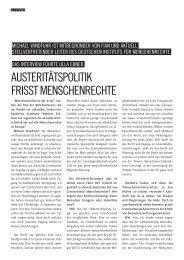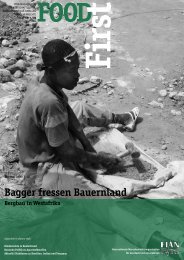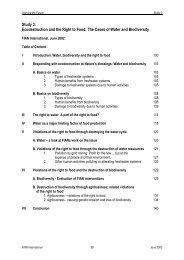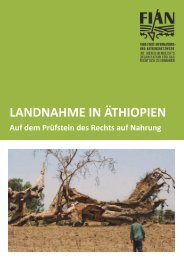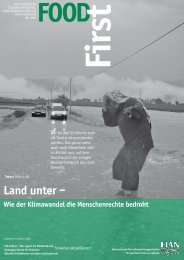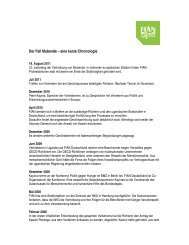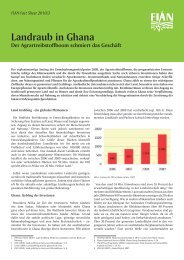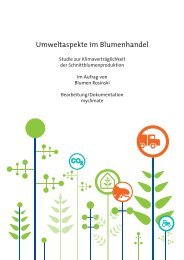(Bio)Fueling Injustice? - Europafrica
(Bio)Fueling Injustice? - Europafrica
(Bio)Fueling Injustice? - Europafrica
You also want an ePaper? Increase the reach of your titles
YUMPU automatically turns print PDFs into web optimized ePapers that Google loves.
While agrofuel related crops are grown in countries where the population already<br />
suffers from undernourishment, it is not even entirely sure whether there would be<br />
enough land available in Africa to fulfil the world’s biofuel needs in addition to<br />
human livelihood needs. Indeed, the estimated figures about the amount of land<br />
needed for biofuel production presented above have to be taken together with the<br />
projected demand of land for food, housing and other essential needs, in a context<br />
where technological progress is unsure and climate change limits the arable land<br />
available (see chapter 2). The UN Special Rapporteur on the Right to Food, Olivier de<br />
Schutter, already estimates that it would be difficult to expand the areas under<br />
cultivation to the degree required to accommodate the growth of rural populations. 281 It<br />
might thus be that the expansion of agrofuel related crops in Africa could have for<br />
consequence that the continent would not have enough land available to fulfil its own<br />
food needs. Although figures about the amount of land necessary for agrofuel<br />
production and the amount of arable land available are contested, and while this issue<br />
still needs to be further researched, as scientific knowledge stands, the idea of an<br />
Africa that cannot become food self-sufficient if agrofuels keep on expanding as<br />
planned cannot be excluded.<br />
BOX 2 THE DIFFICULTY TO ASSESS HOW MUCH ARABLE LAND IS<br />
“AVAILABLE” AND THE CLAIM ON “MARGINAL” LAND<br />
As the International Energy Agency explains: “There may be potential to use<br />
currently unused land, but it is difficult to identify “unused” land, since reliable field data<br />
is lacking on current land-use through smallholders and rural communities. Complex<br />
land tenure structures and lack of infrastructure in rural areas are additional challenges<br />
for the expansion of biofuel production in many African countries.” 282<br />
The HLPE equally indicated: “[I]t must be recognised that expansion of the agricultural<br />
land area will be at the expense of grazed or forest land, with both social and<br />
environmental impacts.”<br />
“Satellite and aerial photos cannot show the invisible elements that are essential for<br />
understanding how land is actually used, the rights of different users of the land, and<br />
existing land-based social relations. And in many countries, cadastral systems<br />
showing registered land claims are extremely problematical, so that official state<br />
records and actual reality do not match. In addition, a large number of smallholder<br />
farmers may have no registered rights to the farmland and commons on which their<br />
incomes and livelihoods depend.<br />
It is often asserted that there is much ‘available’ land in Africa and Latin America. This<br />
suggests abundant unused land. However, there is rarely any valuable land that is<br />
neither already being used in some way, nor providing an important environmental<br />
service. Hence, any taking of land deemed to be ―available‖ will impose some cost,<br />
either on the existing land user, or in environmental services forgone.” 283<br />
In addition, agrofuel investors usually a single large piece of land, while, if there are<br />
tracks of unused land, these are often multiple small pieces within a dynamic and<br />
clustered populated area.<br />
63



